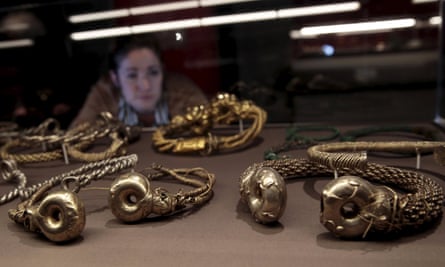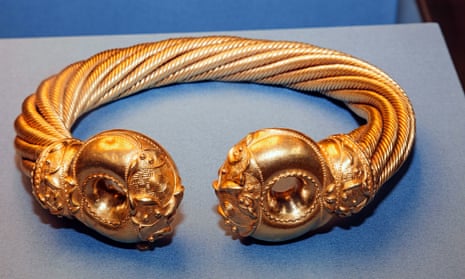A farmer, ploughing a field near Snettisham in Norfolk in 1948, turned up what he thought was a bit of an old brass bedstead. But it was gold, not brass, which he’d discovered and this was just the first piece of the richest iron age hoard ever discovered in Europe, including more than 200 torcs and fragments of torcs: neck rings made of gold, silver and bronze. Today, the collection is in the British Museum, and earlier this year, I was lucky enough to get a close look at some of these beautiful treasures.
I met European iron age collections curator Julia Farley in the bowels of the museum, otherwise known as the Sturge Basement. She had liberated some of the Snettisham artefacts from their glass cases up in the gallery, bringing them down to the basement stores, and now she carefully lifted each of the glittering objects out of its tray and laid it on the sheet of dark grey foam that covered the table.
There were five almost complete torcs and several fragments, including some bits of scrap metal that had been assembled on a loop of gold, looking for all the world like an iron age bunch of keys (the keys to Boudicca’s chariot, we joked). The colour of the torcs varied quite widely – from a bright, brassy gold to reddish gold to silver. All of them were made of alloys of gold, silver and copper, in various proportions. These alloys had been deliberately created, Julia told me, perhaps to achieve a certain colour or to make the metal easier to work.
The selection ranged from some simple gold torcs to the magnificently ornate Great Torc. The simpler torcs were made from twisting just two or three metal rods together, with loops forming the ends, or terminals. But the Great Torc is a breathtaking example of iron age craftsmanship. Here, eight ropes of gold are twisted together to form the neck ring and its terminals have been cast on to it, using a lost-wax technique. The decoration on each terminal is wonderfully intricate: raised arcs of gold sweep across their surfaces, with a line of stamped dots framing each embossed arc. At the facing ends of the terminals, some areas enclosed by the arcs are filled with an incised hatched texture, but there are also areas where the goldsmith resisted the urge to decorate every inch of surface. This type of design, with flowing curves, and a careful balance between dense decoration and empty space, epitomises the British La Tène style of Celtic art.
The metalsmiths who created these works of art took inspiration from continental European designs, but added a local twist. These objects amply demonstrate the artistic flair and impressive technical abilities of those iron age artisans. But recent research on the Snettisham treasures has revealed another level of sophistication. Down in the smart new science labs of the British Museum, I met metallurgist Nigel Meeks. He had been using cutting-edge scientific techniques to reveal the secrets of these iron age masterpieces.
A modestly sized scanning electron microscope, no larger than a small fridge, sat next to an array of screens in the lab. Nigel placed a small fragment of a relatively simple bronze torc in the electron microscope and fired up the machine. The pictures came through in no time, filling the first screen with a hugely magnified view of this twisted piece of torc, in black and white. There were patches of lighter and darker areas on the surface of the metal.
This microscope could do more than just allowing us to visualise the surface of this object; it had an inbuilt spectrometer so it was possible to analyse the elements present on that surface. I selected an area of interest on the dark grey that seemed to represent the background material and the results appeared on a second screen. There was a high peak of copper and another of tin: this torc was indeed made of bronze. Then I chose a portion of the pale area and a totally different series of peaks appeared. There was one very tall spike corresponding with gold; another spike indicated mercury.
“Is that just an impurity in the gold?” I asked Nigel.
“No. You don’t naturally get mercury impurities in gold. The two metals have been deliberately mixed together – this is mercury gilding.”
This technique would have involved mixing grains of gold into mercury and applying the resulting silvery slurry to the bronze. Then, by heating the metal – to over 357C – the mercury would have been driven off, vaporising and leaving the rod coated in a skin of gold. It was iron age alchemy – turning base metal into gold, or at least, into what looked like solid gold. This process never eliminates all the mercury from the surface of the gilt bronze, which is why there was enough left behind in the gold for Nigel’s analysis to pick it up.

This is an extremely early example of fire gilding – for Britain. The technique seems to have been invented around the middle of the first millennium BC, becoming relatively common in the Mediterranean by the 3d century BC. But this 1st century BC torc didn’t look like an exotic import – it was characteristically British. There’s no source of mercury in Britain, so both this metal, and presumably the knowledge of this technique must have come from elsewhere. Archaeologists have discovered late iron age Spanish torcs that, though very different in style from the British one we were looking at, are gilded in the same way. There were also sources of cinnabar, the bright red mercury ore, in Iberia. So it’s possible that the ore, and the idea of fire gilding, arrived in iron age Britain from Spain, along well-used Atlantic seaways.
When we read Greek and Roman accounts of the Celts, we come away with a caricature of uncouth barbarians who wear trousers and drink undiluted wine, who go naked into battle and who are terrified by an eclipse. But archaeology reveals a different story and we glimpse the Celts’ love of art and design, where exquisite jewellery symbolised power and where horse-riding warriors carried beautifully decorated swords and scabbards. We also discover how the Celtic-speaking tribes inhabiting the islands in the far north-west corner of Europe were culturally and technologically linked to their neighbours on the continent: iron age Britain was far from being a backwater.
Celts: Art and Identity is at the British Museum until 31 January. The Celts: Blood, Iron and Sacrifice with Alice Roberts and Neil Oliver starts on 5 October, BBC at 9pm. The Celts by Alice Roberts (Heron) is published 8 October

Comments (…)
Sign in or create your Guardian account to join the discussion